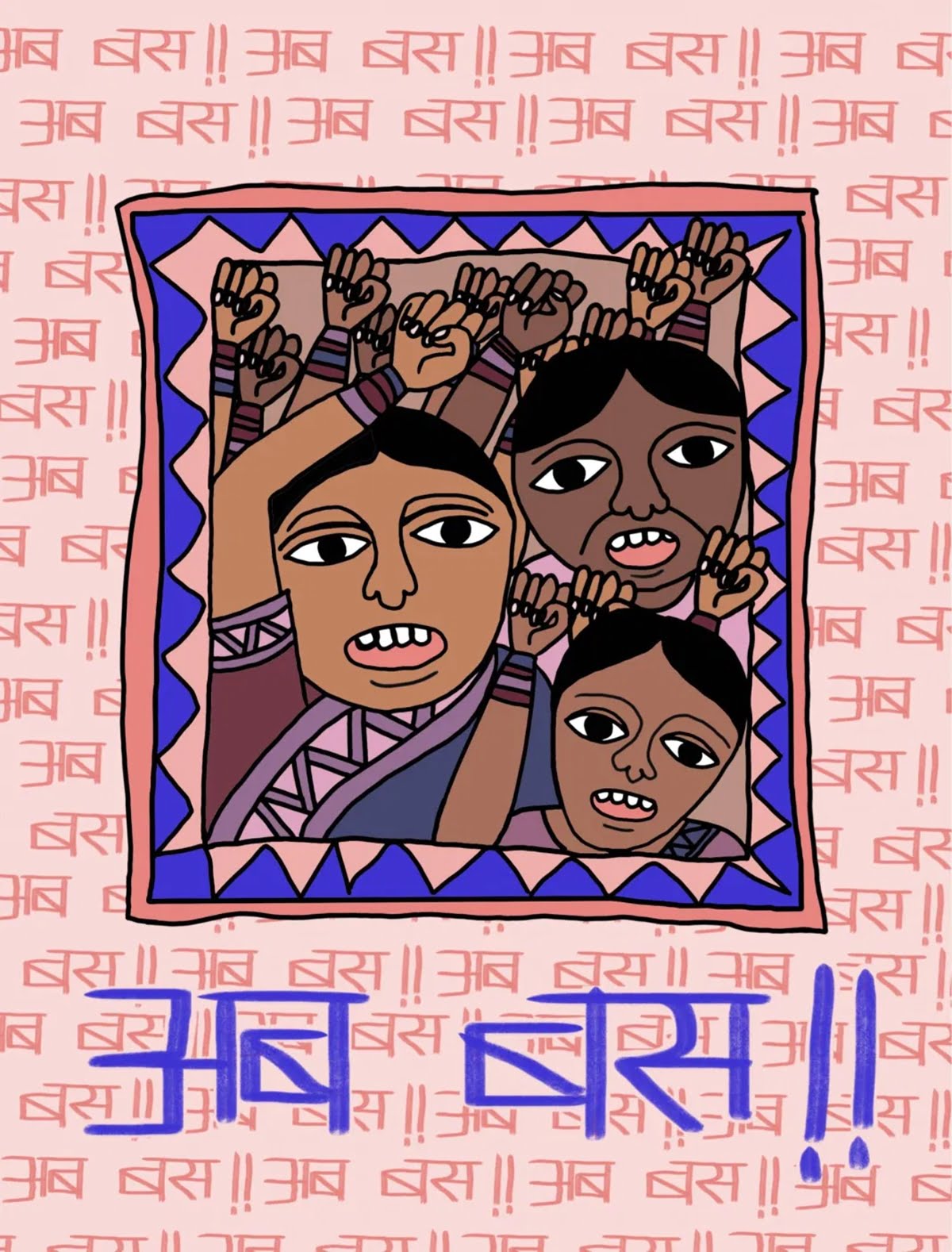“All too often, colonial white women, particularly those who were slave mistresses, chose to differentiate their status from the slaves by treating the slave in a brutal and cruel manner. It was in her relationship to the black female slave that the white woman could best assert her power” — writes bell hooks in her revolutionary book ‘Ain’t I a Woman: Black Women and Feminism‘
Mocking indigenous Jharkhandi languages manifests the meritlessness of the upper castes
In the Indian context, a barbaric system of oppression, where so-called upper-caste women dominate, harass and control women belonging to Scheduled Caste, Scheduled Tribe and Bahujan communities, has hitherto been in existence. Among the ‘influencer’ videos which have recently surfaced on the Internet, some oppressor caste women can be seen mocking the indigenous languages of the domestic workers, others ridiculing their living habits, and accusing them of lack of hygiene. In at least one of the videos, the workers could be seen hiding their faces in discomfort, as they are systemically rendered powerless so as to not be able to say ‘No’ to the employer, given the power dynamics.
With the privacy, identity, and dignity of domestic workers being mocked in public, these videos are not to be taken as an exception. They are only an example, of the derided yet normalised system which has been jeopardising marginalised women from productive castes and communities.
With the privacy, identity, and dignity of domestic workers being mocked in public, these videos are not to be taken as an exception. They are only an example, of the derided yet normalised system which has been jeopardising marginalised women from productive castes and communities.
Also read: 10 Instagram Pages To Follow For An Intersectional Take On Gender And Society
When self-proclaimed upper-caste ‘influencers’ scornfully laugh over the native languages of Jharkhand — languages which have been constructed in consonance with nature; it reflects their discriminatory attitude devoid of any merit to comprehend the nuances of semantics, environment, and power. Laughter, and language which are pre-determined to bring people closer together, then become a tool of oppression, using which the privileged assert their distance and superiority over the marginalised.
How dominant caste influencers practice untouchability in the digital realm
In an Instagram reel, an oppressor caste woman sans mask is seen disparaging the domestic worker who is wearing a mask. Seeming to be shot for creating content for the former’s page, the worker is made to act to look with awe at the influencer, while ‘Don’t mind me just watchin’ plays in the background. The oppressor caste ‘influencer’ is then seen, brimful of disgust, at the prospect of the domestic worker being captured in the video.
Despite the video being a product of acting, it is a clear extension of the inhumane system of untouchability, where upper caste women consider the sight of marginalised women as a bane. To discern that such reels have thousands, and at times, millions of views, exhibit how upper caste influencers who are on the privileged side of the digital divide, instead of acknowledging and working over their privilege; ‘connect’ over casteist content.
The privileged have not countered traditional ‘gender roles’, they have only perpetuated casteism
Data states that post-liberalisation, the number of domestic workers has grown by approximately 120%, given the advent of educated privileged women into the corporate culture. This is not to say that in a conventional heteronormative family set-up, if both the male and female partner work outside, the housework is shared by them equally inside. Privileged men continue to ‘help’ their partners in household chores, instead of sharing responsibilities with their partners.
In such a patriarchal scenario, there arises a chasm. Given how the marginalised have been hitherto deprived of education by the oppressor castes and how the casteist-capitalist system constantly displaces them of their land and forest resources without any safeguarding of their culture, land, or compensation; this leads to an influx of ST, SC, and OBC women into domestic work. However, in award speeches for 30 Under 30, we rarely find an upper-caste woman accept and acknowledge how her career is built on the blood and sweat of Bahujan women.
By infantilising domestic workers in a situation where they have to express obeisance bereft of any bargaining power, these ‘influencers’ erroneously influence their viewers. In another Instagram post, an ‘influencer’ is seen making concocted allegations about her domestic worker’s apparent lack of hygiene and mocking their self-respect. While the videos and posts are the ones that came out by chance, there is no accountability on what goes inside their houses off-camera; and both the probability, as well as the possibility, of discriminatory behavior abound.
‘Upper-caste’ Instagram influencers, as is evident from their discriminatory behaviours at display on their social media, do not consider the bodies and minds of Dalit-Adivasi and Bahujan women workers as dignified, humane, and complete. They are not seen as individuals who think and feel, who have a life and an identity. They are seen as nameless entities existing to serve them, who are not supposed to answer back, or question them, let alone retaliate against unjust behavior.
Also read: Social Media Influencers: Serving Classism, Selective Feminism & Monolithic Nationalism
Instead of reparations, marginalised women are gaslighted
In usual cases of mistakes, the steps that follow when someone is held accountable, are apologies, reparations, and rectifications. Except in a casteist society like ours, where on one hand upper-caste female ‘influencers’ exploit Bahujan women, and on the other hand, they type out posts denigrating affirmative action, that is reservation. Case in point is a video by well, no prizes for guessing, an upper-caste ‘influencer’ on the ‘benefits of being a general category person, which according to them are none, while they go on to list out multiple ‘benefits’ of belonging to the SC/ST/OBC communities.
Viewing such acerbically distressing videos also takes an immense toll on the oppressed caste people, further triggering and traumatising them affecting their mental health. Neither does gaslighting them in the name of apologies undo the wrong. Furthermore, when Bahujan women assert themselves against these harassing videos, the same upper-caste women harass, gaslight, trivialise and threaten them, thereby bolstering a vicious nexus of casteism and power.
Upper caste ‘influencers’ prove how they have no sense of solidarity with the working or living conditions of marginalised women. They deify domestic workers by calling them ‘mothers’ or ‘heroes’.
Upper caste ‘influencers’ prove how they have no sense of solidarity with the working or living conditions of marginalised women. They deify domestic workers by calling them ‘mothers’ or ‘heroes’. Deification is dehumanisation and if any so-called upper caste individual is asked if they would perform all the tasks assigned to the domestic worker at the status-quo salary with deification instead of worker rights; the upper caste would never even consider the plausibility, let alone reflect on the unjust system. They would jeer at the marginalised and move on.
Self-proclaimed upper-caste feminists rightfully speak on the sexist gender pay gap in the corporate world perpetrated by men, but hypocritically go ahead and continue to employ domestic workers for gravely low wages. Privileged women in the organised sector comprehend that period leaves and maternity benefits are imperative and that their denial by men is patriarchal, but unabashedly deprive marginalised domestic workers of the same rights. As sexist as the upper-caste man is who is not present in the kitchen; the upper-caste woman too, gives stale food to the workers in separate, sub-standard utensils and do not pay them deserving wages, thus directly contributing to their inability to move up the social ladder. Where does the idea of all-encompassing feminism then vanish?
Upper-caste women cannot speak on behalf of ‘all women’
Unlike the ‘progressive West’ where an attempt is made to comprehend racism, in the case of India, umpteen self-proclaimed ‘progressive’ upper caste people tend to explicate on domestic workers. They do this without considering the casteist system which upholds and perpetuates the discrimination and injustice meted out to domestic workers. To deny the cause of oppression, while claiming to fight oppression, is an oppression of the worst kind.
Bahujans comprise around 80 percent of the population, and consequently, Bahujan women form a major chunk of the population.
What upper-caste feminists need to understand is that intersectionality is not an optional feature of feminism, it is in fact, the essence of feminism. And that so-called upper-caste women cannot, shall not, and dare not, speak on behalf of ‘all women’; not when they themselves are active when not complacent in the oppression of the marginalised women.
Featured Image Credit: Sunidhi Kothari/Feminism In India
About the author(s)
Ankita Apurva was born with a pen and a sickle.





